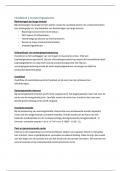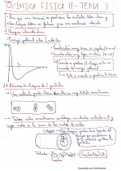Week 1: Lecture 1
Trading on financial markets
Two dominant types of markets:
1. Dealer markets
- Fixed income markets, FX markets, some derivative markets
2. Agency markets/limit order book
- Most stock markets, some derivative markets
Because trading is costly, investors are concerned about market liquidity (à the ability to
trade large quantities of a financial asset quickly, at low cost, and with little impact on the
price).
Market liquidity
- Transaction costs (fixed, variable)
- Depth à how deep is the market? The deeper the market, the larger quantities the
market can absorb
- Price impact à trading quickly will move the price against you (drive the price down)
- Illiquidity is a source of risk
100 basis points = 1 percentage point
Dealer (trading) markets
Buyers and sellers do not trade with each other, but with “dealers” (usually banks) who act
as intermediary and stabilize the market by supplying immediacy.
They charge bid-ask spread as a compensation for the dealer’s risk:
- High price for which you can buy
- Low price for which you can sell
- Difference is compensation
This bid-ask spread compensated for:
- Fixed costs: admin, operation, technology
- Costs of bearing inventory risk (changing prices!)
- Costs of trading against better informed (asymmetric information)
- Potentially also counterparty risk
The competition among different dealers helps to keep bid-ask spreads low.
,Agency markets
Central meeting of demand and supply (e.g. the stock exchange). Buyers and sellers directly
trade with each other. In most agency or auction markets there is one market maker or
specialist for each stock.
Specialist is in charge of:
- Organizing
- If supply and demand are unbalanced, specialist might step in as middleman or
intermediary (relatively rare)
-
Limit order book:
A collection of all the trading interest (indication of interest in buying) that is out there.
Depth of the order book: total number of shares that are offered
Market maker: earning profits with a bid/ask spread
Bid/ask orders: best prices are traded first, then it is based on time (what time is the order
placed)
Inside spread: the difference (bid/ask spread) between the best sell and the best buy offer
that is outstanding in the limit order book
Walking the book: when submitting large orders, trading at successive prices with the best
possible prices that are still available.
As a specialist, better to have high or low inventory?
- Excess buying interest might indicate that current prices are too low and may
increase, from which you can profit with a greater inventory
- If there is a big imbalance between bid & ask, specialist may have to act as
intermediary subsuming the excess buying demand, which is easier with a bigger
inventory from which the specialist can sell
- The main reason for having a low inventory is risk. You do not want to have
inventory when the prices go down
High expected return = risky, therefore price of the stock is lower. à return and price are
inversely related.
Interest rates
Nominal interest rate (R) is the growth rate of the money, and a real interest rate (r) is the
growth of the purchasing power; r ≈ R – i (i is inflation). The exact relationship is given by 1+r
= (1+R)/(1+i) à r = (R-1)/(1+i)
Three basic factors – supply, demand, and government actions – determine the real interest
rate. The nominal rate, which is the rate we actually observe, is the real rate plus the
expected rate of inflation. With a higher expected inflation, the nominal rate ought to
increase to maintain the same real return. This is the so called Fisher equation: R = r + E(i)
,Recent trends and developments in financial markets
1. Institutionalization
Initially, the majority of stocks were owned by households. Now, the majority is owned by
institutions. Why is it beneficial to delegate investment management to institutions?
- Access to knowledge (experience of investment professionals)
- Better monitoring (voting power)
- Diversification
- Economies of scale
What are the disadvantages?
- Personal preferences get less taken into account (depends on the offerings)
- Conflicts of interest between agents and households (differences between the
objectives of these agents and the households)
- Buying power is exploited
- Efficient markets (due these are agents à which is also a benefit) are hard to meet
- Risk-shifting
2. Automated trading
Debate about whether it is a good or a bad trend.
High Frequency Trading (HFT) is good for
- Liquidity
- Market efficiency
However, they are also blamed for increasing excess volatility and for exploiting small retail
investors. We also know little about their behavior in times of stress more generally.
3. Sustainable investing
Care more about just financial risk and return. The impact is now also considered.
Responsible investment is an approach to investing that aims to incorporate environmental,
social and governance (ESG) factors into investment decisions, to better manage risk and
generate sustainable, long-term returns.
Issue: greenwashing
Reason to reflect on your investments:
- Harmful products
- Harmful production processes
- Human rights violations
Three roles that finance can play with regards to sustainability:
1. Capital allocation
- Finance can influence strategic allocation of capital
2. Influence on business
- Shareholders can influence firms through voting an engagement.
3. Risk management / insurance
- Finance tools can help investors and firms manage climate risk
, Week 1: Lecture 2
Deriving Portfolio Theory
Portfolio Theory à How to invest?
The goal of a portfolio manager is to achieve the best possible trade-off between risk and
return.
Hedging: investing in an asset with a payoff pattern that offsets exposure to a particular
source of risk. It involved the purchase of a risky asset that is negatively correlated with the
existing portfolio.
Diversification: investments are made in a variety of assets so that exposure to risk of any
particular security is limited.
3 Portfolio problems
Problem 1 – one risk-free security and one risky security
- Will be a straight line
- You want to maximize the utility:
- The expected return is:
- Portfolio risk:
The optimal portfolio weight W1 can be determined by maximizing the investor’s utility with
the following formula (combination of all of the above):
Risk free security has no risk, thus no variance. Therefore, the third term of the formula is
cancelled out (as variance is 0).
FOC = First Order Condition à the way to find a maximum for a utility function for one
certain derivative function. Optimal portfolio weight:
the higher the expected return, the more money you put in the risky security
the higher the risk averseness, the less money you put in the risky security





